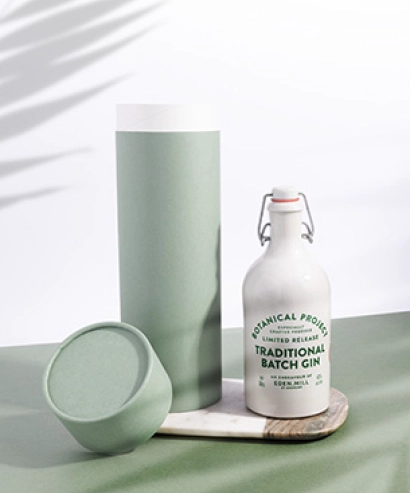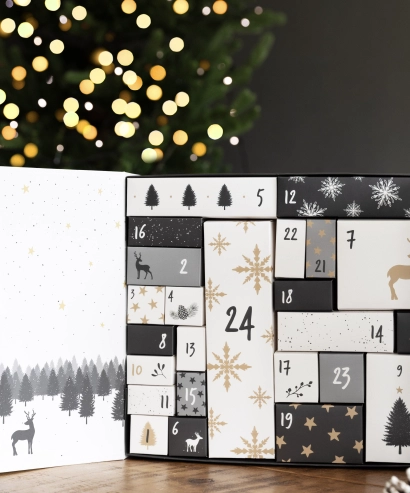Advent calendars are an increasingly popular phenomenon. According to the BBC, more than 16 million were sold in the UK in 2019 and by Christmas 2021, 34% of British adults said they had an advent calendar (YouGov).
Many well-loved brands produce an advent calendar that is tantalisingly loaded with goodies behind each door. They are made for all tastes and all budgets, ranging from Poundshop’s £2.50 chocolate calendar to Tiffany’s £89,000 calendar.
Wait, Poundshop’s calendars are £2.50…?
For small businesses, creating an advent calendar is a creative and engaging way to promote products or services. The challenges are in knowing how to create it, knowing what to put in it and knowing how to price it.
As always, we’ve got you covered.
Creating your advent calendar
The folks at Tiny Box Company have produced this fantastic ready-made calendar. It has an adorable little box for each day of Advent. The hard work is done and all you have to do is decide what to put in the boxes.
If you wish to brand your calendar, contact Tiny Box Company to enquire about beautiful branded stickers.
How to fill your advent calendar
How you approach this depends on what type of business you have but also on how you want to price your calendar.
It is perfectly OK to think outside the box (see what we did there?). All 24 boxes do not have to contain one of your products – we’ve made some suggestions for other fun inclusions below. If there isn’t a product every day, you need to price your calendar accordingly. You also need to be clear in the description about what other kinds of items there are.
What to put in your boxes:
- Product samples: Include small samples of your products in each box. This allows customers to try a variety of items and encourages them to make future purchases.
- Related products of lesser expense: e.g., small candles or chocolates.
- Exclusive discounts: Provide exclusive discounts or special offers for specific products or services. This can incentivise purchases and create a sense of urgency.
- Tips or insights: Add value with tips, or advice related to your business. For example, if you sell wellness products, you could include a card illustrating three yoga poses for a better night’s sleep.
- Gift certificates or vouchers: include gift certificates or vouchers that can be redeemed for products or services. This can drive repeat business.
- Collaboration with other businesses: Partner with complementary businesses to include their products or offers.
- Interactive challenges, games or contests: Engage customers with fun challenges or contests related to your products or industry. Offer prizes or discounts for participation.
Non-product items, such as vouchers or tips, can be beautifully printed and branded to encourage the customer to keep them.
How to price your advent calendar

Don’t be Zoella. Remember Zoella? In 2017, the Instagram influencer, who had a 12 million strong teen fan base, faced fury over her £50 advent calendars. Zoella’s 12-day advent calendar was considered to be wholly unworthy of its price tag and an insult to the fans.
Your advent calendar is a product just like any of your other products so price it similarly, taking your target audience into consideration.
Most people use the cost plus pricing strategy and then tweak this according to target market and competition. The cost plus model adds up all the costs incurred in producing a product and adds your profit to make your selling price.
Therefore, to price your calendar, add the following items.
- Product cost: Calculate the cost of each item included in the calendar. Consider bulk-purchasing discounts if applicable.
- The advent calendar: The cost of the calendar itself.
- Packaging and printing: Factor in the cost of the boxes, any additional packaging materials, and printing custom designs or labels.
- Labour and assembly: Consider the time and effort required to assemble and package each box. This may include labour costs if you hire someone to help.
- Shipping and handling: Include costs for shipping the advent calendars to customers. Free shipping is a powerful buying incentive.
- Overheads and miscellaneous expenses: Account for any additional expenses related to the advent calendar, such as administrative costs or unexpected expenses.
- Profit margin: Decide on an appropriate profit margin that allows you to cover costs and make a reasonable profit.
Then adjust the figure according to your competition and your target market.
Be creative and let your business shine!
Embracing the advent calendar trend for your small business is a fantastic way to connect with customers, generate extra revenue and spread some holiday cheer. With millions of these calendars sold each year, it's clear that people love the excitement they bring.
Maximise your creativity and see what wonderful little items or experiences you can think of to fill your calendar. This could be a really fun exercise.
So, get ready to make your business a part of your customers' Christmas traditions. Cheers to a joyful and successful season ahead.
Good luck!








































